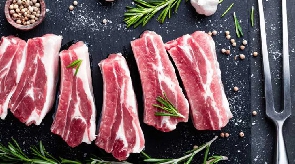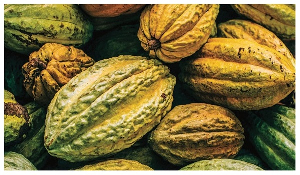Sonnie Badu’s assertion that pork is unclean and easily sets eaters up for demonic attacks has engendered controversy with some rubbishing his claim.
“Once the demons discover that you have eaten something unclean, your spirit automatically gets subdued. Once you go to bed, they come, because you gave them access,” the gospel musician cum preacher said in a sermon and defended his comment after people came at him.
Broadcaster, Blakk Rasta, who is a vegetarian seconded Sonnie Badu; not on spiritual grounds but on health implications as he listed six deadly consequences of eating pork on his radio show.
“Why should anyone be happy about eating pork? This is an animal that has all the abominable diseases,” Blakk Rasta stated.
“It is an animal that is a homosexual. It is an animal that has no respect. And this is your best meat? Listen! Pork has a certain kind of worm that does not die easily. Not even after 100 degrees Celsius of heating. It is called Taenia solium. I remember this from my days of doing general science. Pork has a certain formidable and robust worm that does not easily die.”
Is pork healthy to be eaten or one should avoid it?
Here is an article by healthline.com.
Pork is the meat of the domestic pig (Sus domesticus).
It’s the most commonly consumed red meat worldwide, especially in eastern Asia, but its consumption is forbidden in certain religions, such as Islam and Judaism.
For this reason, pork is illegal in many Islamic countries.
It is often eaten unprocessed, but cured (preserved) pork products are also very common. These include smoked pork, ham, bacon, and sausages.
Being high in protein and rich in many vitamins and minerals, lean pork can be an excellent addition to a healthy diet.
This article tells you everything you need to know about pork.
Nutrition facts
Pork is a high-protein food and contains varying amounts of fat.
A 3.5-ounce (100-gram) serving of cooked, ground pork provides the following nutrients:
Calories: 297
Water: 53%
Protein: 25.7 grams
Carbs: 0 grams
Sugar: 0 grams
Fiber: 0 grams
Fat: 20.8 grams
Pork protein
Like all meat, pork is mostly made up of protein.
The protein content of lean, cooked pork is around 26% by fresh weight.
When dry, the protein content of lean pork can be as high as 89% — making it one of the richest dietary sources of protein.
It contains all nine essential amino acids necessary for your body’s growth and maintenance. In fact, meat is one of the most complete dietary sources of protein.
For this reason, eating pork — or other types of meat — may be particularly beneficial for bodybuilders, recovering athletes, people post-surgery, or others who need to build up or repair muscles.
Pork fat
Pork contains varying amounts of fat.
The proportion of fat in pork usually ranges from 10–16% (2) but can be much higher depending on the level of trimming and other factors.
Clarified pig fat — called lard — is sometimes used as a cooking fat.
Like other types of red meat, pork is mainly composed of saturated fats and unsaturated fats — present in approximately equal amounts.
For example, a 3.5-ounce (100-gram) serving of cooked, ground pork packs about 7.7 grams of saturated, 9.3 grams of monounsaturated, and 1.9 grams of polyunsaturated fat.
The fatty acid composition of pork is slightly different from the meat of ruminant animals, such as beef and lamb.
It’s low in conjugated linoleic acid (CLA) and slightly richer in unsaturated fats.
Summary
High-quality protein is the main nutritional component of pork, making it useful for muscle growth and maintenance. The fat content of pork varies. It’s mainly made up of saturated and monounsaturated fats.
Vitamins and minerals
Pork is a rich source of many vitamins and minerals, including:
* Thiamine. Unlike other types of red meat, such as beef and lamb, pork is particularly rich in thiamine — one of the B vitamins that plays an essential role in various bodily functions.
* Selenium. Pork is rich in selenium. The best sources of this essential mineral are animal-derived foods, such as meat, seafood, eggs, and dairy products.
* Zinc. An important mineral, abundant in pork, zinc is essential for a healthy brain and immune system.
* Vitamin B12. Almost exclusively found in foods of animal origin, vitamin B12 is important for blood formation and brain function. Deficiency in this vitamin may cause anemia and damage to neurons.
* Vitamin B6. A group of several related vitamins, vitamin B6 is important for the formation of red blood cells.
* Niacin. One of the B vitamins, niacin — or vitamin B3 — serves a variety of functions in your body and is important for growth and metabolism.
* Phosphorus. Abundant and common in most foods, phosphorus is usually a large component of people’s diets. It’s essential for body growth and maintenance.
* Iron. Pork contains less iron than lamb or beef. However, the absorption of meat iron (heme-iron) from your digestive tract is very efficient, and pork can be considered an outstanding source of iron.
Pork contains good amounts of many other vitamins and minerals.
Additionally, processed, cured pork products, such as ham and bacon, contain high amounts of salt (sodium).
Summary
Pork is an excellent source of many vitamins and minerals, including thiamine, zinc, vitamin B12, vitamin B6, niacin, phosphorus, and iron.
Other meat compounds
Similarly to plants, animal foods contain a number of bioactive substances — other than vitamins and minerals — that may affect health:
* Creatine. Abundant in meat, creatine functions as an energy source for your muscles. It’s a popular supplement among bodybuilders suggested to improve muscle growth and maintenance.
* Taurine. Found in fish and meat, taurine is an antioxidant amino acid formed by your body. Dietary intake of taurine may be beneficial for heart and muscle function.
* Glutathione. This is an antioxidant, present in high amounts in meat but also produced by your body. Though it’s an essential antioxidant, the role of glutathione as a nutrient is unclear.
* Cholesterol. A sterol found in meat and other animal-derived foods, such as dairy products and eggs. Moderate intake of cholesterol does not affect cholesterol levels in most people.
Summary
Pork contains a number of bioactive meat compounds, such as creatine, taurine, and glutathione, that may benefit health in various ways.
Health benefits of pork
Pork is high in various healthy vitamins and minerals, as well as high-quality protein. Adequately cooked pork can make an excellent part of a healthy diet.
Maintenance of muscle mass
Like most animal foods, pork is an excellent source of high-quality protein.
With age, maintaining muscle mass is an important health consideration.
Without exercise and proper diet, muscle mass naturally degenerates as you get older — an adverse change that is associated with many age-related health problems.
In the most severe cases, muscle wasting leads to a condition called sarcopenia, which is characterized by very low levels of muscle mass and decreased quality of life. Sarcopenia is most common among older adults.
Inadequate intake of high-quality protein may accelerate age-related muscle degeneration — increasing your risk of sarcopenia.
Eating pork — or other protein-rich foods — is an excellent way to ensure sufficient dietary intake of high-quality protein that may help preserve muscle mass.
Improved exercise performance
Meat consumption is not only beneficial for maintaining muscle mass but may also improve muscle function and physical performance.
Aside from being rich in high-quality protein, pork contains a variety of healthy nutrients that are beneficial for your muscles. These include taurine, creatine, and beta-alanine.
Beta-alanine is an amino acid your body uses to produce carnosine, which is important for muscle function.
In fact, high levels of carnosine in human muscles have been linked to reduced fatigue and improved physical performance.
Following vegetarian or vegan diets — which are low in beta-alanine — reduces the amount of carnosine in muscles over time.
In contrast, high dietary intake of beta-alanine — including from supplements — increases muscle carnosine levels.
As a result, eating pork — or other rich sources of beta-alanine — may be beneficial for those who want to maximize their physical performance.
Pork and heart disease
Heart disease is the main cause of premature death worldwide.
It includes adverse conditions like heart attacks, strokes, and high blood pressure.
Observational studies on red meat and heart disease have found mixed results.
Some studies show an increased risk for both processed and unprocessed red meat, many an increased risk for processed meat only, while others have not found any significant link.
There is no clear-cut evidence that meat itself causes heart disease. Observational studies only reveal associations but cannot provide evidence for a direct cause-and-effect relationship.
It’s clear that a high meat intake is linked to unhealthy lifestyle factors, such as low consumption of fruit and vegetables, less physical activity, smoking, and overeating.
Most observational studies try to correct for these factors.
One popular hypothesis links the cholesterol and saturated fat content of meat to an increased risk of heart disease.
However, dietary cholesterol has little or no effect on cholesterol levels in most people and many scientists don’t consider it a health concern.
The link between saturated fats and heart disease is controversial and some scientists have started to downplay its role in heart disease.
Pork and cancer
Cancer is a serious disease, characterized by uncontrolled growth of cells in the body.
Many observational studies note a link between red meat and colon cancer risk — although the evidence is not entirely consistent.
It’s difficult to prove that pork causes cancer in humans as observational studies cannot provide evidence for a direct cause-and-effect relationship.
Still, the idea that a high intake of meat causes cancer is plausible. This especially applies to meat cooked under high heat.
Overcooked meat may contain a number of carcinogenic substances — most notably heterocyclic amines.
Heterocyclic amines are a family of unhealthy substances found in relatively high amounts in well-done and overcooked meat, fish, or other sources of animal protein.
They’re formed when animal protein, such as pork, is exposed to very high temperatures during grilling, barbecuing, baking, or frying.
Studies suggest that foods high in heterocyclic amines raise the risk of several types of cancer, such as of the colon, breast, and prostate.
Despite this evidence, the role of meat consumption in developing cancer is still unclear.
In the context of a healthy diet, moderate intake of adequately cooked pork probably does not increase your risk of cancer. Yet, for optimal health, it seems sensible to limit your consumption of overcooked pork.
Adverse effects and individual concerns
Eating raw or undercooked (rare) pork should be avoided — especially in developing countries.
That’s because raw pork may contain several types of parasites that can infect humans.
Pork tapeworm
The pork tapeworm (Taenia solium) is an intestinal parasite. It sometimes reaches a length of 6.5–10 feet (2–3 meters).
Infection is very rare in developed countries. It’s a greater concern in Africa, Asia, and Central and South America.
People get infected by eating raw or undercooked pork.
Most of the time, it’s completely harmless and doesn’t cause symptoms.
However, it may occasionally lead to a disease known as cysticercosis, estimated to affect approximately 50 million people each year.
One of the most serious symptoms of cysticercosis is epilepsy. In fact, cysticercosis is considered to be a leading cause of acquired epilepsy.
Parasitic roundworms
Trichinella is a family of parasitic roundworms that cause a disease known as trichinosis or trichinellosis.
Though this condition is uncommon in developed countries, eating raw or undercooked (rare) pork may increase your risk — especially when the meat is from free-ranging, wild, or backyard pigs.
Most often, trichinellosis has very mild symptoms, such as diarrhea, stomach pain, nausea, and heartburn — or no symptoms at all.
Still, it can develop into a serious condition, especially in older adults.
In some cases, it may lead to weakness, muscle pain, fever, and swelling around the eyes. It may even be fatal.
Toxoplasmosis
Toxoplasma gondii is the scientific name of a parasitic protozoan — a single-cell animal only visible in a microscope.
It’s found worldwide and estimated to be present in approximately one-third of all humans.
In developed countries, such as the United States, the most common cause of infection is the consumption of raw or undercooked pork.
Usually, infection with Toxoplasma gondii does not cause symptoms, but it may lead to a condition known as toxoplasmosis in people with weak immune systems.
Symptoms of toxoplasmosis are generally mild, but it may be detrimental to an unborn child and life-threatening in people with weak immune systems.
Though pork-borne parasites are uncommon in developed countries, pork should always be eaten when well-cooked all the way through.
The bottom line
Pork is the world’s most popular type of meat.
It’s a rich source of high-quality protein, as well as various vitamins and minerals.
Therefore, it may improve exercise performance and promote muscle growth and maintenance.
On the negative side, consumption of both undercooked and overcooked pork should be avoided.
Overcooked pork may contain carcinogenic substances, and undercooked (or raw) pork may harbor parasites.
Though not exactly a health food, moderate consumption of properly prepared pork can be an acceptable part of a healthy diet.
Click to view details



LifeStyle of Friday, 24 February 2023
Source: www.ghanaweb.com

















